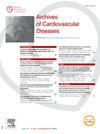Impact of anomalous aortic origin of a coronary artery on coronary angiography: A retrospective analysis
IF 2.3
3区 医学
Q2 CARDIAC & CARDIOVASCULAR SYSTEMS
引用次数: 0
Abstract
Introduction
Anomalous aortic origins of coronary arteries (AAOCA) are not uncommon and are often a challenge for coronary angiography (CA) operators. A detailed evaluation of the effect of AAOCA on CA may help to target the good levers to improve AAOCA catheterisation.
Objective
The objective of this study is to evaluate the impact of AAOCA on the quality of CA catheterisations, as well as the associated costs in terms of time, radiation and contrast injection.
Method
We conducted a retrospective analysis at Félix Guyon University Hospital on Réunion Island, reviewing 23,625 CA cases from May 2011 to December 2022. We identified 96 cases of AAOCA, each matched with a control based on examination type, year, operator, sex, and age. The primary endpoint was the rate of optimal catheterization defined according the position of the distal part of the catheter downstream of the coronary ostium, resting on the coronary artery. Secondary measures included catheterization failure rates, optimal image quality rates, procedural time, radiation exposure, and contrast media use. Qualitative variables were independently evaluated by three experienced operators.
Results
The study found that the optimal catheterization rate for AAOCA patients was significantly lower compared with controls (27.8% vs. 90.6%, p < 0.001). Secondary results highlighted a catheterization failure rate of 7.2% for AAOCA versus 0% for control patients (p < 0.001). The AAOCA cases showed inferior image quality, longer procedural times (31.5 ± 18.2 min vs. 30.9 ± 20.5 min, p < 0.001), increased fluoroscopy time (11.5 ± 7.8 min vs. 6.9 ± 5.0 min, p < 0.001), increased radiation dose (320.5 ± 357.3 vs. 189.9 ± 182.6 mGy·cm2, p < 0.001), and higher contrast used (99.6 ± 62.7 ml vs. 61.2 ± 54.4 ml, p < 0.001).
Conclusion
The presence of AAOCA resulted in a significant reduction in the quality of the catheterisation procedure, despite an increase in the cost of time, radiation and contrast. These findings suggest that a standardised protocol may be beneficial in improving the quality of CA catheterisation in cases of AAOCA.
冠状动脉异常起源对冠状动脉造影的影响:回顾性分析
冠状动脉异常起源(AAOCA)并不罕见,通常是冠状动脉造影(CA)手术的一个挑战。详细评估AAOCA对CA的影响可能有助于找到改善AAOCA置管的好杠杆。本研究的目的是评估AAOCA对CA置管质量的影响,以及在时间、辐射和造影剂注射方面的相关成本。方法回顾性分析2011年5月至2022年12月在雷姆苏因岛fsamlix Guyon大学医院发生的23,625例CA病例。我们确定了96例AAOCA病例,根据检查类型、年份、操作人员、性别和年龄,每个病例都与对照相匹配。主要终点是最佳置管率,根据导管远端位于冠状动脉口下游的位置来确定。次要测量包括置管失败率、最佳图像质量率、手术时间、辐射暴露和造影剂使用。定性变量由三名经验丰富的操作员独立评估。结果研究发现AAOCA患者最佳置管率明显低于对照组(27.8% vs. 90.6%, p <;0.001)。次要结果显示,AAOCA患者的置管失败率为7.2%,而对照组为0% (p <;0.001)。AAOCA病例图像质量较差,手术时间较长(31.5±18.2 min vs. 30.9±20.5 min, p <;0.001),透视时间增加(11.5±7.8 min vs. 6.9±5.0 min, p <;0.001),辐射剂量增加(320.5±357.3 vs. 189.9±182.6 mGy·cm2, p <;0.001),使用更高的对比度(99.6±62.7 ml vs. 61.2±54.4 ml, p <;0.001)。结论尽管时间、放疗和造影剂成本增加,但AAOCA的存在显著降低了置管过程的质量。这些发现表明,标准化的方案可能有利于提高AAOCA病例CA导管的质量。
本文章由计算机程序翻译,如有差异,请以英文原文为准。
求助全文
约1分钟内获得全文
求助全文
来源期刊

Archives of Cardiovascular Diseases
医学-心血管系统
CiteScore
4.40
自引率
6.70%
发文量
87
审稿时长
34 days
期刊介绍:
The Journal publishes original peer-reviewed clinical and research articles, epidemiological studies, new methodological clinical approaches, review articles and editorials. Topics covered include coronary artery and valve diseases, interventional and pediatric cardiology, cardiovascular surgery, cardiomyopathy and heart failure, arrhythmias and stimulation, cardiovascular imaging, vascular medicine and hypertension, epidemiology and risk factors, and large multicenter studies. Archives of Cardiovascular Diseases also publishes abstracts of papers presented at the annual sessions of the Journées Européennes de la Société Française de Cardiologie and the guidelines edited by the French Society of Cardiology.
 求助内容:
求助内容: 应助结果提醒方式:
应助结果提醒方式:


